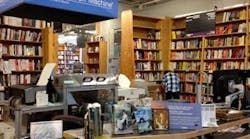Jim Montague is the executive editor for Control. Email him at [email protected].
I've learned to be careful not to write off old technologies. Computers and software were going to get rid of paper? Nope. Electronic and programmable controls would replace pneumatics? Not really. Wireless will get rid of wires? Please. TV is going to kill radio and movies? Ha, now you're reaching.
So, while I'm well aware that new technologies often blend with older ones rather than replace them entirely, I still was slightly blindsided by one of the latest examples I've encountered.
SEE ALSO: Machine Builder Spotlight: M&R Printing Equipment
A couple of weeks ago, I'm walking around Powell's City of Books in Portland, Oregon, and my eldest daughter, Clara, says there's something I have to see. All too familiar with my professional interest in machines, she leads me around a corner, and there is a refrigerator-sized machine attached to an industrial Xerox printer on one side and a sleek Epson printer on top of the other side. Together, they're busily printing pages and paperback covers, and then turning out full-sized, physical, hold-in-your-hand books!
Pretty cool, but it was just about the last thing I expected to see among the stacks of a legendary, second-hand book store. I mean, books are all going Amazon and digital. E-books don't need paper, right? Well, not so fast.
The two guys tending the machine told me it's an Espresso Book Machine (EBM) 2.2 by On Demand Books in New York. The Xerox prints the pages, the Epson does the covers, and in the middle of it all, Espresso assembles, glues and trims them into books that can be up to about 800 pages (Figure 1). They added that the machine's three sections take orders from and are coordinated by On Demand's On Demand Books.
I also took a quick look through Espresso's transparent outer panels, and saw a variety of Festo pneumatic components driving its handling equipment and a linear motion device running its glue pot and applicator (Figure 2). It also had a GE Quick Panel HMI on the outside of the control panel, and I think it also had a Bison motor, but it was hard to tell for sure. Check out this video of Espresso in action.
The guys added that Espresso has been available for about five years, and that On Demand had been running it as a concession at Powell's, but it did so well that the store decided to buy it in February.
"Print-on-demand is another growing part of the printing industry," says Forrest Johnson, Powell's Espresso Book specialist. "It's mostly self-publishing right now, but there are also a lot of people who want hardcopies of their digital books. We can print from PDF files, reprint public-domain books published before 1920; and some of the big publishers such as Penguin, Harper Collins and Random House are beginning to make some of their out-of-print titles available, too. This way, many books never will have to be out of print again."
Of course, old technologies applied in new ways aren't likely to take over the mainstream as they once did, but niche and even artisan-level applications can be useful and often profitable. And, the lessons they can teach and the innovations they can inspire are priceless for future operators, technicians and engineers.
Similarly, the last time I looked, they were using a lot of calculators in my younger daughters' junior and high schools, but they still instill all the basic mathematical concepts before they let them start pushing buttons. That's because a lot of older know-how, traditional values and methods of abstract and critical thinking still are helpful in the present, and will continue to be useful in the future — whatever new tools and methods they help create.





